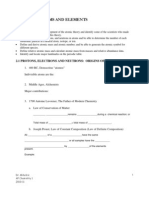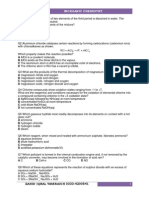A. Precedure/ Data Collection (15 Marks)
Uploaded by
Davies MasumbaA. Precedure/ Data Collection (15 Marks)
Uploaded by
Davies MasumbaQuestion 2
In this experiment you are going to carry out qualitative analysis to identify cation, and anion present
in solution Y and Z. The two solutions contain different cations and anions but solution Z contains a
cation not specified in the chemistry 5070 syllabus.
A. PRECEDURE/ DATA COLLECTION [15 marks]
Using the chemicals and apparatus provided, carry out the following tests on sample solution Y and Z
and record your observations as specified in the qualitative notes provided. You should also test and
identify any gas(es) evolved.
Test Test Observation
No
1
Divide 2ml of sample solution Y into 4
test – tubes.
2
(a) To a portion of solution Y in a test - (a)……………………………………………...
tube, add 2 drops of aqueous sodium
…………………………………………………
hydroxide.
(b) Now add excess aqueous sodium (b)………………………………………………
hydroxide.
…………………………………………………
3 (a) To the other portion of solution Y in
a test – tube, add 2 drops of aqueous
(a)………………………………………………
ammonia.
…………………………………………………
(b) Now add excess aqueous ammonia.
(b)………………………………………………
…………………………………………………
4 (a) To the other portion of solution Y in
the test – tube, acidify with 4 drops of
(a)………………………………………………
nitric acid, then add aqueous silver
nitrate. …………………………………………………
(b)………………………………………………
(b) Now add barium nitrate.
…………………………………………………
5
Divide 2ml of sample solution Z into
2 test – tubes.
6 (a) To a portion of solution Z in a test –
tube, acidify with nitric acid, then add
(a)………………………………………………
barium nitrate.
…………………………………………………
(b) Now add lead (II) nitrate.
(b)………………………………………………
B. RESULTS ANALYSIS AND CONCLUSION [5 marks]
1. Write the formula of the cation and anion present in Y.
Cation: __________________________________ Anion: _______________________________
2. The formula of an ion present is Z is _________________________________________________
3. Deduce the formula for the compound present in sample solution Y.
______________________________________________________________________________
4. The process which results in the formation of barium sulphate is called
______________________________________________________________________________
You might also like
- Lab 13 Qualitative Analysis of Cations and Anions100% (1)Lab 13 Qualitative Analysis of Cations and Anions8 pages
- Programme For The Cross-Over Overnight To 2021100% (4)Programme For The Cross-Over Overnight To 20211 page
- Exemplar For TASK of Identifying Iron (III) SulfateNo ratings yetExemplar For TASK of Identifying Iron (III) Sulfate3 pages
- Teodor James - Lab _ Qualitative AnalysisNo ratings yetTeodor James - Lab _ Qualitative Analysis3 pages
- F5 Chemistry Lab - Qualitative Analysis of Unknown Sample X 2024No ratings yetF5 Chemistry Lab - Qualitative Analysis of Unknown Sample X 20241 page
- Las4 - Analysis of Groups i and II CationsNo ratings yetLas4 - Analysis of Groups i and II Cations8 pages
- 04_Ions_PostLab_Fall24_1.docx679502b4c3cd556161_1-1737910697.9970522 (1)No ratings yet04_Ions_PostLab_Fall24_1.docx679502b4c3cd556161_1-1737910697.9970522 (1)9 pages
- Task 2: 1. Qualitative Analysis (Salt Analysis)No ratings yetTask 2: 1. Qualitative Analysis (Salt Analysis)3 pages
- Determination of Cation and Anion of The SubstancesNo ratings yetDetermination of Cation and Anion of The Substances12 pages
- 06 - E06 M Cation II Analysis 2021.02.05No ratings yet06 - E06 M Cation II Analysis 2021.02.058 pages
- Important Questions - Qualitative AnalysisNo ratings yetImportant Questions - Qualitative Analysis3 pages
- Qualitative Analysis Lab (Ammonium Aluminium Sulphate)No ratings yetQualitative Analysis Lab (Ammonium Aluminium Sulphate)2 pages
- Qualitative Analysis For Identification of Metal Cations50% (4)Qualitative Analysis For Identification of Metal Cations8 pages
- Chemistry Lab Report - Qualitative Analysis100% (2)Chemistry Lab Report - Qualitative Analysis4 pages
- Chem 106 Exp 6 Qualitative Analysis I - Cations INo ratings yetChem 106 Exp 6 Qualitative Analysis I - Cations I8 pages
- Lab 8 CHM130LL Identification of Cations and AnionsNo ratings yetLab 8 CHM130LL Identification of Cations and Anions6 pages
- Experiment 1: Qualitative Analysis of Cations: Ag, Fe, Cu and Ni100% (1)Experiment 1: Qualitative Analysis of Cations: Ag, Fe, Cu and Ni8 pages
- Identify The Cation and Anion in A Mixture of Inorganic CompoundNo ratings yetIdentify The Cation and Anion in A Mixture of Inorganic Compound22 pages
- Qualitative Analysis Experiment AS P3 2024 Q3 May 2024 9701No ratings yetQualitative Analysis Experiment AS P3 2024 Q3 May 2024 97013 pages
- Eddited S.5 NO TWO END of TERM III 2023 Prepared by Mubi TonnyNo ratings yetEddited S.5 NO TWO END of TERM III 2023 Prepared by Mubi Tonny12 pages
- (A) Physical Properties of Salt: Colourless SolutionNo ratings yet(A) Physical Properties of Salt: Colourless Solution4 pages
- 2021 Term 1 Grade 8 Integrated Science Test 150% (2)2021 Term 1 Grade 8 Integrated Science Test 14 pages
- Kaminzekenzeke Day Secondary School Grade 9 Mock Result AnalysisNo ratings yetKaminzekenzeke Day Secondary School Grade 9 Mock Result Analysis2 pages
- 2024 NW JETS PRESENTATION ON DUTIES OF THE DISTRICT JETS COORDINATORSNo ratings yet2024 NW JETS PRESENTATION ON DUTIES OF THE DISTRICT JETS COORDINATORS15 pages
- 2021 Term 1 Grade 12 Science Paper 1 Test 2No ratings yet2021 Term 1 Grade 12 Science Paper 1 Test 22 pages
- Kaminzekenzeke Day Secondary School Grade 12 Mock Result Analysis - 2013No ratings yetKaminzekenzeke Day Secondary School Grade 12 Mock Result Analysis - 20131 page
- 2021 Grade 12 Science Paper 1 End of Term 1 TestNo ratings yet2021 Grade 12 Science Paper 1 End of Term 1 Test5 pages
- 2021 Grade 11 Science Paper 1 End of Term 1 TestNo ratings yet2021 Grade 11 Science Paper 1 End of Term 1 Test4 pages
- 2021 Grade 11 End of Term 1 Science Paper 2 Test100% (1)2021 Grade 11 End of Term 1 Science Paper 2 Test3 pages
- 2021 Grade 10B2 Science Paper 2 End of Term TestNo ratings yet2021 Grade 10B2 Science Paper 2 End of Term Test1 page
- Conditions For Ammonia Production by Haber ProcessNo ratings yetConditions For Ammonia Production by Haber Process5 pages
- 2021 Term 1 Grade 11 Science Paper 2 Test 1 ResultsNo ratings yet2021 Term 1 Grade 11 Science Paper 2 Test 1 Results2 pages
- Chemistry Syllabus For Grade 11S Term 1 of 2021No ratings yetChemistry Syllabus For Grade 11S Term 1 of 20219 pages
- 2021 Term 1 Grade 11 Science Paper 1 Test 2No ratings yet2021 Term 1 Grade 11 Science Paper 1 Test 24 pages
- 2019 End of Term 3 Chemistry Test ResultsNo ratings yet2019 End of Term 3 Chemistry Test Results3 pages
- Atomic Structure and The Periodic TableNo ratings yetAtomic Structure and The Periodic Table27 pages
- Kaminzekenzeke Secondary School Test AnalysisNo ratings yetKaminzekenzeke Secondary School Test Analysis1 page
- Mufumbwe District Education Board: 2013 Grade Seven Results AnalysisNo ratings yetMufumbwe District Education Board: 2013 Grade Seven Results Analysis2 pages
- Evaluation of The Flocculation and Dewatering PerformanceNo ratings yetEvaluation of The Flocculation and Dewatering Performance9 pages
- CHEMISTRY NOTES CHAP 2 (Electronic Structure of Atoms) AutosavedNo ratings yetCHEMISTRY NOTES CHAP 2 (Electronic Structure of Atoms) Autosaved18 pages
- Objective Chem Stry: and Other Medical Entrance Examinations100% (1)Objective Chem Stry: and Other Medical Entrance Examinations615 pages
- Chemistry Education in The 21st CenturyNo ratings yetChemistry Education in The 21st Century106 pages
- Laboratory Manual (Inorganic and Organic Chem)No ratings yetLaboratory Manual (Inorganic and Organic Chem)89 pages
- Corrosion of Copper and Copper Alloys: Ahmed JabirNo ratings yetCorrosion of Copper and Copper Alloys: Ahmed Jabir14 pages
- SOLUBILITY OF RARE EARTH OXIDES IN MOLTEN FLUORIDES XiaolingGuoNo ratings yetSOLUBILITY OF RARE EARTH OXIDES IN MOLTEN FLUORIDES XiaolingGuo7 pages
- Atomic Structure: N.C. Aparajitha 1020719BD015 Department of Physical ScienceNo ratings yetAtomic Structure: N.C. Aparajitha 1020719BD015 Department of Physical Science47 pages






















































































































